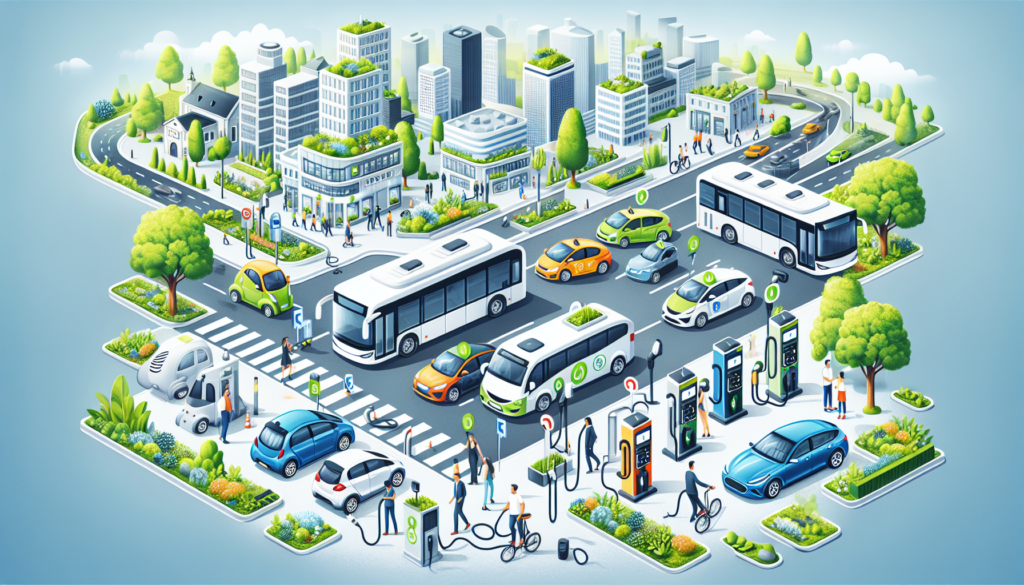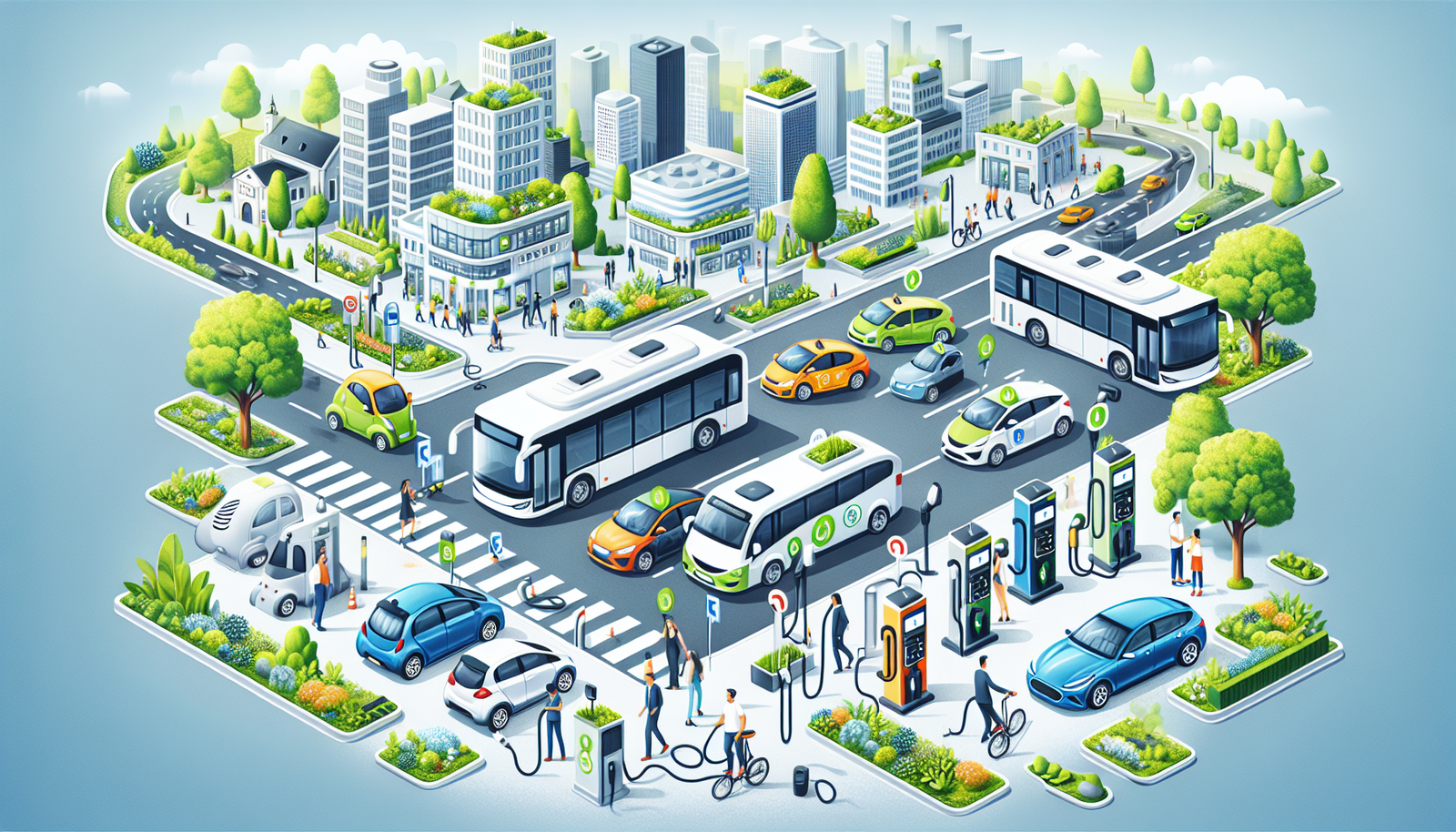Imagine a world where the streets are filled with silent, emission-free vehicles, and the air we breathe is cleaner than ever before. Picture a future where governments play a vital role in promoting a sustainable transportation system, steering towards a greener and healthier planet. In the realm of electric vehicle policies, it is essential to understand the core environmental goals that drive governments to implement such initiatives. By doing so, we can gain insight into the collective efforts to combat climate change, reduce air pollution, and preserve the Earth’s natural resources.
Reducing greenhouse gas emissions
Decreasing dependence on fossil fuels
To reduce greenhouse gas emissions, one of the main goals of government EV policies is to decrease dependence on fossil fuels. Traditional vehicles powered by gasoline or diesel contribute significantly to carbon dioxide emissions, which are a major contributor to climate change. By promoting the use of electric vehicles (EVs), which are powered by electricity and do not produce tailpipe emissions, governments aim to reduce the overall reliance on fossil fuels for transportation.
Promoting renewable energy sources
Another environmental goal of government EV policies is to promote the use of renewable energy sources for charging EVs. While EVs themselves do not produce emissions during operation, the source of electricity used to charge them plays a crucial role in determining their overall environmental impact. Governments encourage the development and adoption of renewable energy sources such as solar, wind, and hydroelectric power to ensure that the charging of EVs does not contribute to greenhouse gas emissions.
Lowering carbon footprint
By decreasing dependence on fossil fuels and promoting renewable energy sources, government EV policies aim to lower the carbon footprint associated with transportation. Carbon footprint refers to the total amount of greenhouse gas emissions, particularly carbon dioxide, produced directly and indirectly by a person, organization, or product. EVs have the potential to significantly reduce carbon footprints when compared to conventional vehicles, making them an important tool in the fight against climate change.
Improving air quality
Reducing vehicle emissions
Government EV policies also prioritize the reduction of vehicle emissions to improve air quality. Traditional vehicles emit pollutants such as nitrogen oxides, particulate matter, and volatile organic compounds, which contribute to poor air quality and pose health risks. By transitioning to electric vehicles, which produce zero tailpipe emissions, governments aim to reduce these harmful pollutants and improve the overall air quality in urban areas.
Eliminating pollutants
In addition to reducing vehicle emissions, government EV policies also focus on eliminating other pollutants that contribute to poor air quality. For example, regulations may be put in place to restrict the release of harmful volatile organic compounds during the manufacturing of EV components. By targeting various sources of pollutants, governments aim to create a cleaner and healthier environment for everyone.
Minimizing health risks
Improved air quality resulting from the adoption of electric vehicles can lead to significant health benefits. Exposure to pollutants emitted by traditional vehicles has been linked to respiratory problems, cardiovascular diseases, and other health issues. Government EV policies seek to minimize these health risks by reducing emissions and promoting the use of clean and electric transportation options, ensuring that communities can thrive in a healthier and safer environment.

Mitigating climate change
Limiting global temperature rise
Government EV policies play a crucial role in mitigating the effects of climate change by aiming to limit the rise in global temperatures. The transportation sector is a major contributor to greenhouse gas emissions, which trap heat in the Earth’s atmosphere and lead to global warming. By transitioning to electric vehicles, which have lower emissions compared to their fossil fuel-powered counterparts, governments hope to reduce the overall greenhouse gas emissions and contribute to the stabilization of global temperatures.
Reducing the impacts of climate events
Another important goal of government EV policies is to reduce the impacts of climate events, such as extreme weather conditions, caused by climate change. Electric vehicles, through their reduced emissions, contribute to the reduction of greenhouse gases that are responsible for the intensification of climate events. By mitigating climate change, governments aim to protect communities from the devastating impacts of floods, heatwaves, hurricanes, and other extreme weather events.
Adapting to changing climate patterns
As climate patterns continue to change, governments recognize the importance of adapting to these shifts. Government EV policies may include initiatives to develop and promote EV technologies that can withstand the challenges posed by changing climate patterns. This could involve improving battery technology to ensure optimal performance in extreme temperatures or developing charging infrastructure resilient to the impacts of climate change. By adapting to changing climate patterns, governments strive to ensure the continued effectiveness and sustainability of electric transportation systems.
Conserving natural resources
Preserving depletable resources
Conserving natural resources is another crucial aspect of government EV policies. Traditional vehicles heavily rely on depletable resources such as petroleum, a fossil fuel that contributes to greenhouse gas emissions and is finite in supply. By transitioning to electric vehicles, governments aim to reduce the demand for these depletable resources, thereby preserving them for future generations. This shift promotes a more sustainable approach to transportation and ensures the long-term availability of vital resources.
Protecting biodiversity
Government EV policies also emphasize the protection of biodiversity, which refers to the variety of life forms in ecosystems. Traditional vehicles contribute to habitat destruction and fragmentation through the extraction and transportation of fossil fuels. By promoting electric vehicles and renewable energy sources, governments aim to minimize the negative impacts on ecosystems and protect biodiversity, ensuring the survival of diverse species and natural habitats.
Sustainable land use
Promoting sustainable land use is another important goal of government EV policies. Conventional vehicles require extensive road infrastructure and parking spaces, often leading to urban sprawl and the conversion of valuable land for transportation purposes. Electric vehicles, however, offer opportunities for more sustainable land use. With the development of efficient public transport systems and the promotion of active transportation modes such as walking and cycling, governments can prioritize land conservation, preserve green spaces, and create livable communities.
Promoting sustainable transportation
Encouraging environmentally-friendly commuting
One of the objectives of government EV policies is to encourage environmentally-friendly commuting habits. This includes promoting alternatives to single-occupancy vehicle trips, such as carpooling or using shared mobility services, to reduce the number of vehicles on the road. By incentivizing and supporting sustainable commuting options, governments aim to decrease congestion, improve air quality, and reduce overall energy consumption associated with transportation.
Developing efficient public transport systems
Government EV policies also focus on the development of efficient and sustainable public transport systems. Investing in public transit infrastructure, such as electric buses and trains, allows for the movement of larger numbers of people while minimizing energy consumption and reducing emissions. By providing accessible, reliable, and affordable public transportation options, governments can encourage individuals to choose sustainable alternatives to private vehicles.
Creating infrastructure for electric vehicles
To support the widespread adoption of electric vehicles, government EV policies prioritize the creation of infrastructure for charging EVs. This includes installing public charging stations in parking lots, highways, and urban areas, as well as providing incentives for businesses and homeowners to install private charging stations. By expanding the charging infrastructure network, governments aim to alleviate concerns about range anxiety and ensure that EV owners have convenient access to charging facilities, making the transition to electric transportation more viable for everyone.
Reducing noise pollution
Quieter electric vehicles
Electric vehicles offer the advantage of being significantly quieter compared to traditional vehicles powered by internal combustion engines. Government EV policies address the issue of noise pollution by promoting the use of electric vehicles, which contribute less to noise disturbances in urban and residential areas. By transitioning to EVs, governments aim to enhance the overall quality of life by reducing noise pollution and creating more peaceful and tranquil environments.
Minimizing noise disturbances
In addition to reducing noise pollution from vehicle operations, government EV policies also aim to minimize noise disturbances associated with charging infrastructure. Efforts may be made to ensure that charging stations are located in appropriate areas, away from residential or noise-sensitive zones. By considering noise impacts during the planning and implementation of charging infrastructure, governments seek to minimize potential disruptions and maintain a harmonious living environment for all.
Enhancing quality of life
Reducing noise pollution through the promotion of electric vehicles contributes to enhancing the quality of life for individuals and communities. Excessive noise has been linked to various negative effects, such as increased stress levels, impaired sleep, and reduced overall well-being. By prioritizing measures to reduce noise pollution, governments create more pleasant living environments, ultimately leading to improved physical and mental health outcomes for residents.
Supporting clean energy transition
Facilitating the shift to renewable energy
Government EV policies play a pivotal role in supporting the transition to clean and renewable energy sources. By setting targets and implementing supportive measures, governments aim to facilitate the adoption of renewable energy technologies and accelerate the transition away from fossil fuels. This may involve providing financial incentives for renewable energy projects, streamlining regulatory processes, and fostering collaboration between the public and private sectors to drive clean energy innovation.
Improving energy efficiency
Another important goal of government EV policies is to improve overall energy efficiency. While electric vehicles offer environmental benefits, it is crucial to consider the entire lifecycle energy consumption, including manufacturing, charging, and disposal. Governments, therefore, focus on promoting energy-efficient practices and technologies in the production and use of EVs. By maximizing energy efficiency throughout the EV lifecycle, governments aim to minimize energy waste and maximize the environmental benefits of electric transportation.
Promoting energy conservation
Government EV policies also emphasize the importance of energy conservation. Encouraging individuals and businesses to adopt energy-saving measures, such as using electric vehicles for specific purposes or implementing smart charging systems, contributes to reducing overall energy consumption. By promoting energy conservation in conjunction with the adoption of electric vehicles, governments aim to achieve a more sustainable and balanced energy future.
Creating green jobs
Boosting employment in the clean energy sector
Government EV policies aim to create green jobs by boosting employment opportunities in the clean energy sector. As the demand for electric vehicles and renewable energy sources continues to grow, there is a need for skilled workers in areas such as manufacturing, research and development, and green infrastructure development. By providing training programs, incentives, and support for clean energy businesses, governments stimulate job creation and contribute to an inclusive and sustainable economy.
Fostering innovation and technological advancements
Government EV policies also foster innovation and technological advancements in the clean energy sector. By investing in research and development, governments encourage the discovery and implementation of new technologies that improve the performance, efficiency, and affordability of electric vehicles and renewable energy systems. Through collaborations with academia, industry, and research institutions, governments aim to drive innovation and create opportunities for entrepreneurs and businesses to thrive in the clean energy space.
Driving economic growth
The promotion of electric vehicles and the transition to clean energy have the potential to drive economic growth. Government EV policies focus on creating an ecosystem that supports the growth of sustainable industries, such as EV manufacturing, charging infrastructure development, and renewable energy generation. By supporting these sectors and creating market opportunities, governments stimulate economic growth, attract investments, and position their countries as leaders in the global clean energy market.
Addressing environmental justice
Reducing disparities in access to clean transportation
Government EV policies actively address disparities in access to clean transportation. Traditionally, low-income communities and marginalized populations have been disproportionately affected by air pollution and have limited access to sustainable transportation options. Government interventions focus on improving access to electric vehicles, charging infrastructure, and public transit in underserved communities, ensuring that all individuals have equal opportunities to benefit from clean transportation solutions.
Minimizing environmental burdens on disadvantaged communities
In line with the principle of environmental justice, government EV policies aim to minimize the environmental burdens borne by disadvantaged communities. Efforts are made to ensure that the siting of electric vehicle charging stations and other clean transportation infrastructure does not disproportionately impact vulnerable communities or exacerbate existing environmental inequalities. By prioritizing equity and fairness, governments seek to create a more inclusive and sustainable future for all.
Ensuring equitable distribution of benefits
Government EV policies also prioritize the equitable distribution of the benefits associated with clean transportation. This includes ensuring that disadvantaged communities have access to the economic, health, and environmental benefits derived from electric vehicles and renewable energy sources. Governments work towards eliminating barriers, such as financial constraints or lack of information, and actively engage with communities to understand their specific needs and tailor policies that address their concerns. By ensuring equity in the transition to clean transportation, governments foster social cohesion and improve overall well-being.
Fostering international cooperation
Sharing best practices and knowledge
Government EV policies foster international cooperation by encouraging the sharing of best practices and knowledge across countries. Recognizing that climate change and environmental issues require collective efforts, governments collaborate to exchange insights, experiences, and successful strategies in promoting electric vehicles and sustainable transportation. Through platforms such as international conferences, partnerships, and multilateral agreements, governments aim to accelerate the global transition to clean transportation and achieve shared environmental goals.
Collaborating on global climate agreements
Another area of international cooperation facilitated by government EV policies is collaboration on global climate agreements. Governments work together to negotiate and strengthen international agreements, such as the Paris Agreement, which aims to limit global warming and promote sustainable development. By participating in these agreements and committing to shared targets, governments demonstrate their dedication to addressing climate change and contribute to global efforts in mitigating its impacts.
Working towards a sustainable future
Government EV policies emphasize the collective goal of working towards a sustainable future for all. By fostering international cooperation, governments acknowledge the interconnectedness of environmental challenges and the need for collaborative action. Through joint research initiatives, technology sharing, and capacity building programs, governments strive to find innovative solutions and promote sustainable practices that can benefit societies worldwide. By working together, governments can create a more sustainable future and ensure the well-being of future generations.


